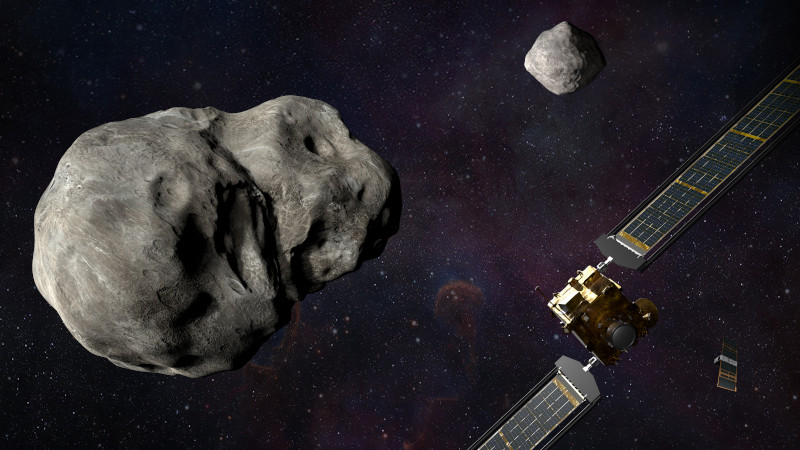Got any plans for tonight? No? Well then you’re in luck, because NASA is just a few hours from intentionally smashing a probe into the minor planet Dimorphos as part of Double Asteroid Redirection Test (DART) — marking the first time humanity has ever intentionally tried to knock a space rock off-course. If it works, we’re one step closer to having a viable planetary defense system in case we ever detect an asteroid on a collision course with Earth. If it doesn’t work. . . well, we’ve still got time to come up with another plan.
To be clear, the 170 meter (560 feet) wide Dimorphos DOES NOT pose any threat to us, nor will it after NASA smacks it around with an ion-propelled spacecraft. This is simply a test to see if a small spacecraft impacting an asteroid head-on can slow it down enough to appreciably change its orbital trajectory. We won’t know for a week or so if the impact did the trick, but it should still be fascinating to watch the crash happen live.
We’ve embedded the two NASA streams below. The first one will start about a half an hour before impact and is going to show live navigational images of Dimorphos as the DART spacecraft zeros in on its target, and the second stream will cover the main event. Keep in mind this isn’t a Hollywood film we’re talking about — don’t expect any dramatic explosions when the clock hits zero. When the telemetry stops coming back, that means it was a bullseye.

















” This is simply a test to see if a small spacecraft impacting an asteroid can change its velocity enough to appreciably change its orbital trajectory. ”
Demonstrating that nukes aren’t required.
“Where’s the Ka-Boom?
There was supposed to be an asteroid shattering Ka-Boom!”
18mins to go, lock on target was sucessful
Nailed it, last few seconds there it was like…
https://www.youtube.com/watch?v=wY57Vn0qTiU
@RW ver 0.0.3, thanks for the link to only YouTube Ads :-(
Gee I hope the asteroid doesn’t want to get insurance involved.
Mission (finally) accomplished! https://xkcd.com/1740/
B^)
I wish I’d known of the camera feed; I got so tired of looking at a speck in the corner while motormouths blathered on about History and No Danger…
170 meters, is that really no danger at all?
The asteroid’s trajectory doesn’t intersect Earth’s.
It does now!
Amazon: we would have failed to crash :D
I wonder if the next mission will be to land softly, grab the asteroid and then ignite a large thruster, so instead of an impact producing an impulse, they can give a sustained push.
Pool with planets from red dwarf springs to mind. Perhaps we can push Mars into the goldilocks zone with a domino like chain reaction.
The advantage of smashing into the asteroid is that you can get there quicker, and the impact itself is pretty simple.
The delta-V should be the same.
tl;dr: You can’t “land softly” without reversing your thrust first, and that not only takes more time, it also uses up a lot of fuel that could have gone toward moving the rock. A lot of these are discovered without much warning, so you don’t want to be tip-toeing around.
No, it’s actually *better*. When the spacecraft hits the surface, it throws up ejecta broadly travelling opposite the impactor (basically, part of the asteroid “just keeps going”) which means the total delta-v is *higher*. Not small either.
The downside is that impacts are harder to predict because it depends on composition and topography.
Landing a thruster also is a pain because asteroids spin.
@Tom Nardi said: “This is simply a test to see if a small spacecraft impacting an asteroid head-on can slow it down enough to appreciably change its orbital trajectory. We won’t know for a week or so if the impact did the trick, but it should still be fascinating to watch the crash happen live.”
Hi Tom. I’m sorry, I don’t have the time to research the answer to this question… Please tell us HOW they are going to measure any change to the orbital trajectory. I know there’s an Italian CubeSat that Dart let go before the impact, but nothing further on that I can find. I find it highly unlikely monitoring the orbital trajectory change of the target, being it is so small and far away, is possible from Earth-based sensors. But I may be wrong.
Obviously, the asteroid is big enough to be observed from the Earth, since they already knew where it was.
This is why they chose the double asteroid. They will just look if treir orbit around each other changes perceptibly.
It’s a moon of another body, which is why it was chosen. You don’t have to monitor the position: you measure the orbital period with eclipses. Much easier to get precision. Also how they know it won’t be a threat: it changes the moon more than the system.
Hence “double” in DART.
Hubble and Webb would like to say hello, but they’re too busy taking photos.
For a long time there, up until the very last 20 seconds before hit, it looked more like some Privateer beta missing the cockpit graphics.
Damn, that fraction of a frame. The spacecraft was trying to send picture at the very last moment
Reminds me of the Ranger(s) that died trying to get that last pic sent…
This is called: “Poking the Celestial Bear” Even if it’s not Ursa Major (or Minor). Don’t do it…
The asteroid they hit was literally a billion times too small to destroy the earth. Even if it fell to earth (which would be impossible with how little they pushed it), the most damage it would do is probably break some windows or level a few houses (if it hit them directly).